October 7, 2020
Dear Students, Faculty, Staff, Alumni, and Families,
I hope you are staying well and bearing up during this difficult time. We are midway through this historic fall semester; time for a fall update.
Seven months after COVID-19 forced us to disperse back in March, we are fortunate to have more than half our students on campus, with nearly as many studying remotely. I have the great privilege of living on the campus and have loved seeing it enlivened after so many quiet months. I am also grateful for a beautiful fall with plenty of sunlight on the shades of red, russet, yellow, and gold as the leaves change.
Everyday joy was the focus of the assigned summer reading for new students this year, Ross Gay’s The Book of Delights. Gay, a prize-winning poet, decided to write a short essay about an experience of delight every day for a year, by hand, each in one sitting. In conversations with two groups of new students, I marveled at the openness with which they shared their own experiences of delight, while also exploring, as Gay does, the relationship between joy and sorrow. Taking notice of our experiences of delight, however small, helps us weather the many reasons for sorrow and worry in this world of COVID-19, deep political division, job losses, overt promotion of racism and denial of its systemic forms, and the increasingly destructive effects of climate change. That so many of you look these problems in the eye and are committed to change is reason for hope. Please exercise your right to vote.
As many of you know from previous communications and webinars, we spent day and night over many months planning for the safest possible return to campus for students, staff, and faculty. Move-in days in August were more like drop-off days this year, with parents delivering students to one central location and College staff taking it from there. Despite the emotional challenges of such a quick transition, I have heard only gratitude from families who have thanked our staff for the logistical ease of the process and the staff’s warmth and helpfulness.
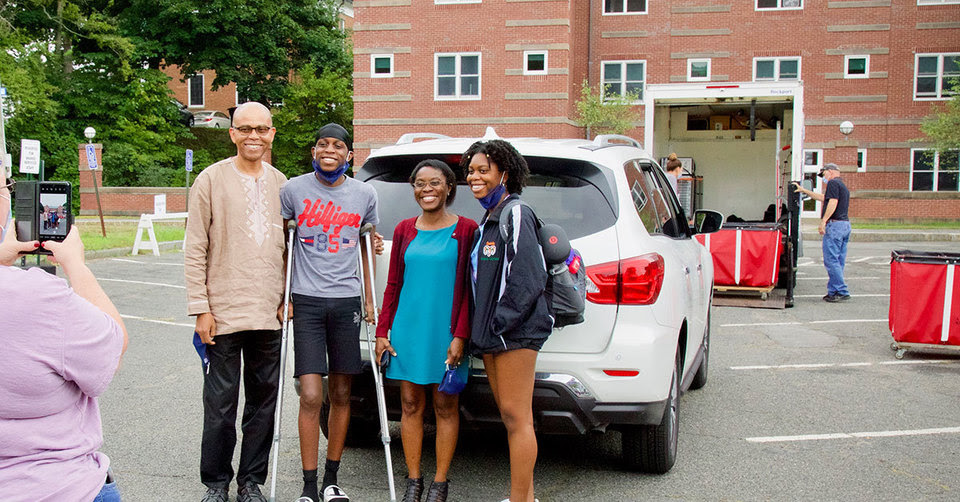
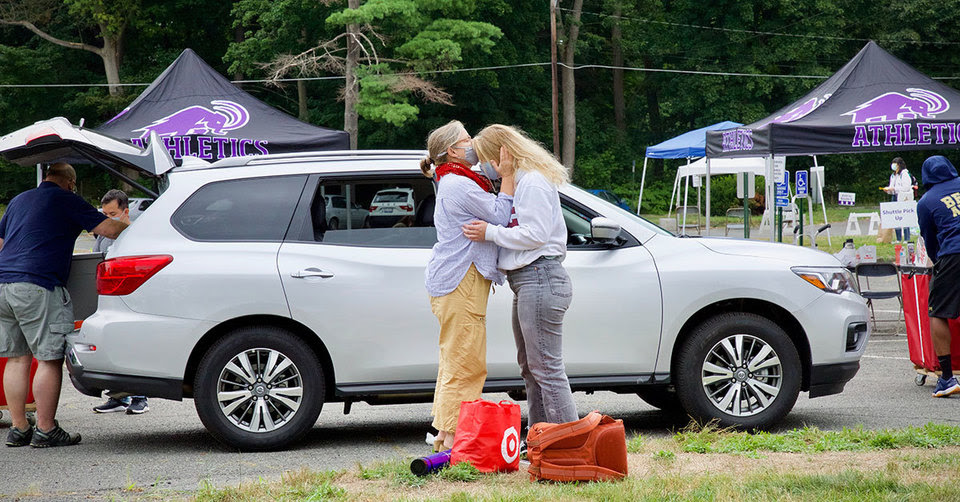
Move-In Days, August 2020
We were happy to welcome the 433 members of the class of 2024 to our community. Our newest students hail from 40 states, the District of Columbia, Puerto Rico, and 31 foreign countries. The new class brings a wide range of impressive talents, distinctions, and prestigious scholarships (including National Merit, ROTC, Gates, UNCF, and Schuler scholarships, among others). They arrive from 358 different secondary schools, more than half of them public. First-generation college students make up 13 percent of the class. Forty-nine percent identify as students of color. Thirteen percent are international students. Among our first-years, nine are Native American and Pacific Islanders—Chamorro, Chippewa, Hawaiian, Mono Lake Paiute, Northern Cheyenne, Potawatomi, Pueblo, and Samoan. We welcome 14 new transfer students, seven of whom transferred from community colleges around the country, and one of whom is a military veteran. Three hundred sixty-eight members of the class of 2024 are on campus this fall and 65 are learning remotely. Approximately 50 students decided to take a gap year.
A Transformed Campus
Our staff continues to do a heroic job designing and implementing the public health protocols that have allowed us to bring students to campus and help protect them. Student arrivals were carefully staggered, with arrangements for students to quarantine while awaiting two negative test results. In addition to masks, enhanced hand-washing, and careful physical distancing, we have robust testing and contact tracing systems in place and arrangements for isolation and quarantine spaces, as needed. Students are tested three times a week, and faculty and staff who regularly work on campus, twice weekly. Our tests are processed by the Broad Institute of MIT and Harvard, with results typically available in less than 24 hours. You can read more about our protocols, see a map of our campus “bubble,” and view our COVID-19 dashboard, which is updated each weekday. So far, we have had three positive tests—out of nearly 29,000 administered—all occurring in the earliest days of arrivals. This past week, testing revealed what is called a persistent positive, someone who had been infected and recovered but continues to test positive at times. This person has now had two negative results after the “persistent positive” result.

Students in line to be tested for COVID-19 upon arrival on campus.
All students are living in single-occupancy rooms, with several residence halls set aside as quarantine and isolation spaces. We switched to a grab-and-go model for dining. Meals are available at multiple locations around campus and we have added new “late night” dining hours, which have turned out to be very popular. More recently, we found a way to allow students to order food from local restaurants, with one delivery company and all orders going directly to a clearinghouse on the edge of campus where students pick up their food. Large tents on our quads host some classes, office hours, and social gatherings; fortunately, the weather to date has cooperated. While all intercollegiate competition is canceled for the fall semester, our athletes are continuing to train with their coaches, in physically distant ways in small groups, four or five times a week. NESCAC presidents voted to allow spring sports to practice with coaches this fall as well, and team members studying remotely are staying engaged with their teams and attending team meetings virtually when possible.
Students who opted to return to campus agreed to abide by guidelines designed to keep the community safe, and they have done a good job overall of adhering to them. Students grasp how important these measures are and many seem proud to be participating in their success. But students also find the restrictions extremely difficult—and there is no doubt that they are. They are not allowed to leave campus or have visitors, given the importance of maintaining a “bubble.” And we have not allowed social gatherings in groups larger than 10. I wish our students, whether studying remotely or on campus, could have more of the experiences they would otherwise be having. I find their ability to connect with one another and enjoy their courses, in spite of the many restrictions, to be impressive. On campus, our Book & Plow Farm has never been more popular; students have reported rising early and walking with a few friends to the farm for sunrise, practicing yoga together there, or gathering at sunset and delighting in the incredible number of stars we see in our nighttime skies here in Western Massachusetts.
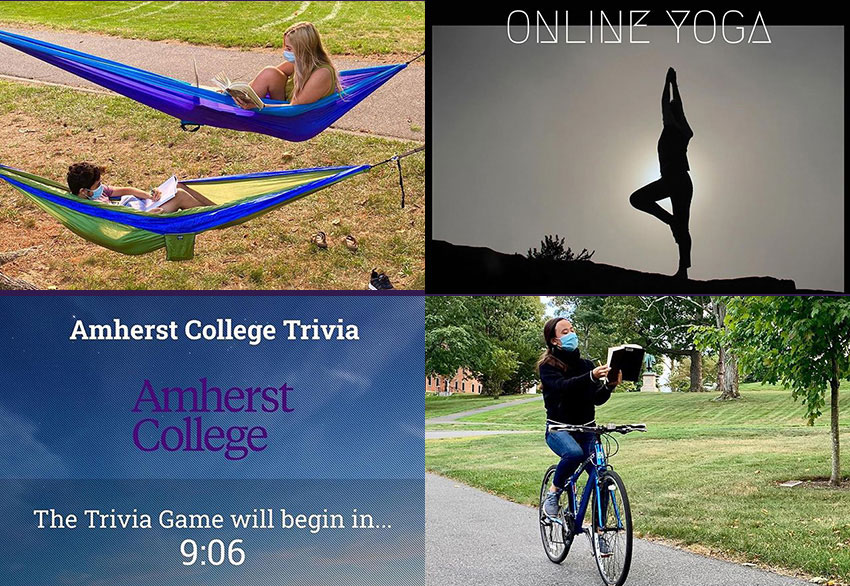
Students have been resourceful about staying active and engaged on campus.
The success we have had to date has led some students to request that we relax the rules we established, while others ask that we do a more consistent job of enforcing the rules. We have made some changes in response to student requests—allowing the delivery of food from local restaurants, for instance. We have identified additional indoor gathering and study spaces where students can gather with friends from other dorms; and we are extending the hours when popular study spots are open. Students, on campus and off, will soon be hearing from Student Affairs staff about a new slate of programming and opportunities to stay active and engaged. Most of the precautionary measures we put in place will stay in place, however—not despite our success, but because those measures are the reason we have been able to mitigate the risk of spread. The rules are designed to create “a bubble,” as every public health expert we consulted advised us to do. Were it possible to create a perfect “bubble,“ we could relax restrictions to a greater degree, but we cannot create a completely impermeable bubble. Students’ adherence is not perfect. Staff and faculty, who are tested regularly, must come and go, and they are also at greater risk overall of serious illness than students are.
We are especially concerned about student wellbeing and mental health during this unusual semester, given all its constraints, and have tried to anticipate needs and provide support to ease the stress that affects students whether they are studying on campus or remotely. The Counseling Center has made additional resources available, including telehealth options as well as one-on-one and small group support meetings, available to students on campus and to those studying remotely. Student Affairs has launched “Mammoth Connections,” a program through which staff and faculty members connect by phone or email with students who are interested in having contact. Clubs and other organizations are finding more effective ways to include students studying remotely while engaging those on campus. Student leaders are facilitating connections in small groups among those who are learning remotely and in different time zones. And our talented Student Activities staff and Events team are booking events for October and November that will help create a greater sense of community and, hopefully, decrease the loneliness and stress that we know many students, staff, and faculty are experiencing.
Pedagogical Dedication and Innovation
With a heritage of 200 years of excellence in teaching and research, our faculty’s extraordinary response to the challenges of this time comes as no surprise. After listening carefully to feedback from students about their experience of remote learning last spring, over 90 percent of faculty teaching this semester dedicated their summer months to becoming more familiar with the techniques and strategies that enhance remote and hybrid instruction. Many participated in a six-week course development seminar, based on a curriculum designed by the Association of College and University Educators. Staff from our Center for Teaching and Learning partnered with IT’s Academic Technology Services unit to facilitate discussion and the exchange of ideas among five cohorts of faculty. Others worked in partnership with 2U, an industry leader in providing online educational experiences, to develop expertise in mounting larger classes with significant asynchronous and synchronous content.
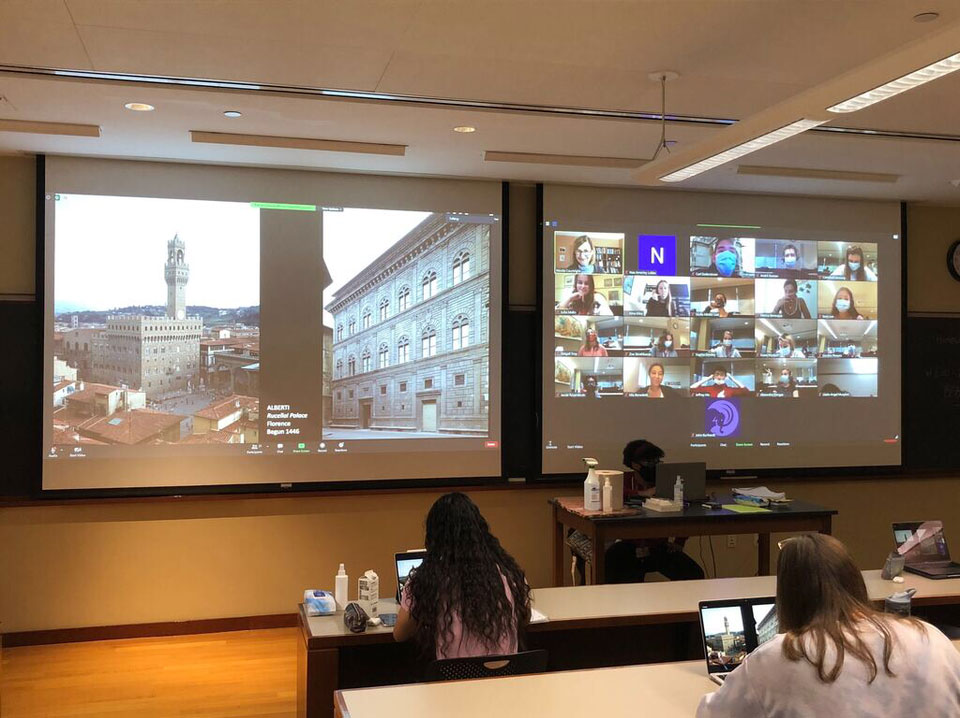
In ARHA-135 Early Modern European Art and Architecture, some students are in a classroom on campus while others join by Zoom. Here, William McCall Vickery 1957 Professor of the History of Art Nicola Courtright remotely controls a slideshow while a student teaching assistant at the front of the classroom helps manage the multiple streams of input.
Faculty members revamped syllabi, revised assignments and assessments, became more adept at using new technological tools, and fine-tuned class elements in order to create the best possible conditions for meaningful and rewarding student engagement. Professors designed new ways to promote a sense of community right from the first day of classes (or, in some cases, even earlier). They also developed entirely new courses that provide students with historical context for the moment we are in. Bertrand H. Snell 1894 Professor in American Government Martha Umphrey and John E. Kirkpatrick 1951 Professor Adam Sitze, both in the Department of Law, Jurisprudence, and Social Thought, along with Associate Professor of Russian Michael Kunichika, are teaching a colloquium on pandemics and governance. The colloquium focuses on plagues and pandemics over a wide span of time. Texts include Thucydides' The Peloponnesian War and Sophocles' Oedipus Rex, as well as writings of Daniel Defoe, Albert Camus, and contemporary theorists.
All of us look forward to the time when we can return to in-person learning. Early results from a recent student survey confirm what we know about the importance of residential education: remote learning, no matter how creative, is no substitute for the benefits of human presence in the kind of education Amherst offers. The full array of adaptations faculty are offering this semester is nonetheless impressive. Opportunities abound for students to share the work they are doing. Office hours are occasions for virtual group discussions as well as for one-on-one meetings with professors (in-person and remotely). Many professors have designated times for virtual gatherings in which students can conduct independent work in parallel, providing the sense of companionship that working side-by-side at the library or elsewhere on campus would otherwise offer. If you haven’t already seen it, you may want to read William Nelson Cromwell Professor of Jurisprudence and Political Science, Associate Provost and Associate Dean of the Faculty Austin Sarat’s article about teaching in the pandemic, “The Best in Education Wasn’t Lost When Colleges Went Online.”
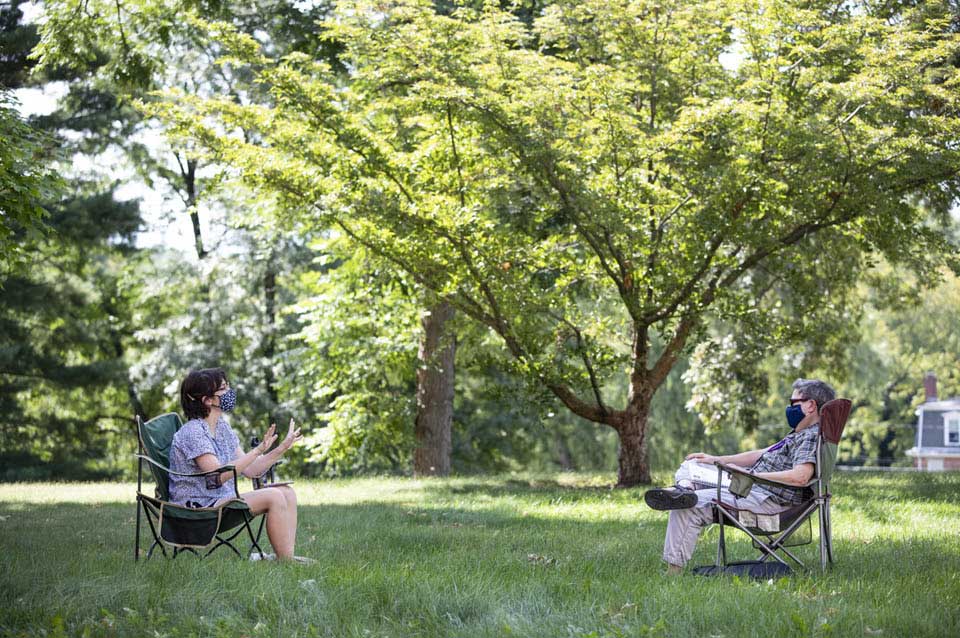
Eliza J. Clark Folger Professor of English Judith Frank meets with Julia Shea ’21 about her thesis project.
Our arts faculty and students are rising to the challenges of this moment beautifully. Sculpture classes are meeting outdoors; dance classes are creating site-specific experiences on campus, with technological resources for remote interaction. The music department has created two very special compilations of our singers and musicians playing together, even while apart. Take a moment to listen to the Amherst College Horn Ensemble playing Ave Maria (originally composed for men's chorus by Franz Biebl, arranged for horn ensemble by Kate O'Brien Vance), directed by French horn instructor Jean Jeffries and video-edited by Helena Burgueño '19. You will also enjoy the beautiful rendition of Three Gifts (composed by Lisa Smith Van der Linden '89) by the Amherst College Virtual Choir, directed by Choral Director Arianne Abela.
Even in the circumstances we face, faculty continue to design new and more effective ways to inspire our students. I was particularly impressed by our STEM Incubator, one of many programs designed to ensure that all students can flourish and achieve what they set out to do, regardless of the differences among them in high school preparation. The project was completely adapted—in its inaugural year, no less—to meet the challenges created by COVID-19. Designed and run by Assistant Professor of Biology Marc Edwards, Assistant Professor of Chemistry Christopher Durr, and Assistant Professor of Statistics Brittney Bailey, the intensive six-week summer program offered a cohort of 18 students from groups underrepresented in STEM disciplines exposure to current research topics in chemistry, biology, and statistics while developing students’ fundamental research skills. The move to virtuality was made possible through a variety of technical solutions including Zoom, Slack, Moodle, MURAL, and the use of iPads. Students were introduced to staff in the Writing Center, Loeb Center for Career Exploration and Planning, and Frost Library, who will support them throughout their time at the College and beyond. And the virtual mode facilitated students’ connections with alumni working in scientific fields through a Friday Colloquium speaker series.
Amidst all of this change and adaptation, we welcomed 10 new tenure-track faculty members this August. Working in the fields of biology, chemistry, computer science, English, environmental studies, geology, neuroscience, psychology, religion, and statistics, these remarkable scholar-teachers have come to Amherst with outstanding research and teaching experience and degrees from a wide range of top public and private universities around the country. The group includes an Amherst graduate. These new faculty members are already bringing new energy and ideas to the life of the College.
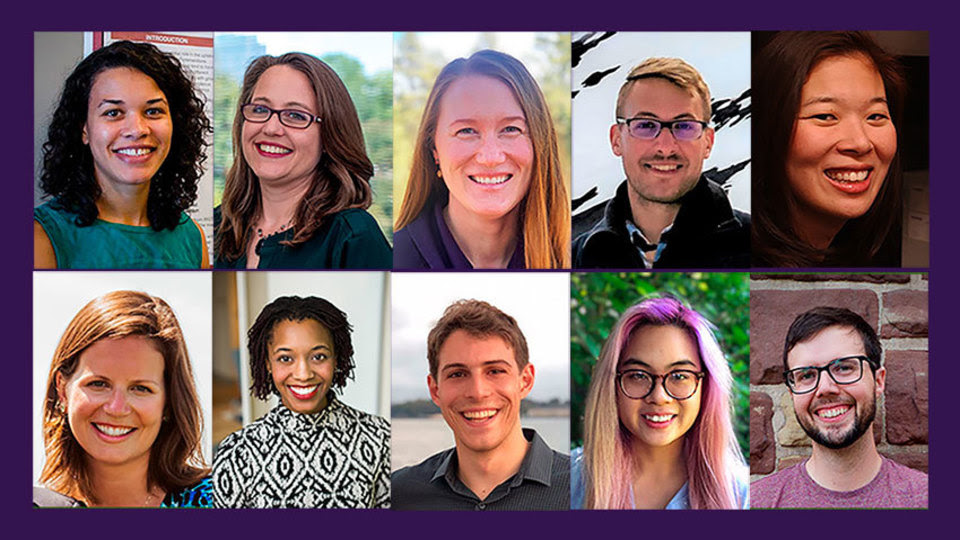
The College welcomed 10 new tenure-track faculty members this summer.
Accomplishments and Recognition
Our faculty members continue to receive national recognition for their scholarship, research, and publications. To name just a few recent examples, Professor of English and American Studies Lisa Brooks, Associate Professor of American Studies Kiara Vigil, and their colleagues in the Five College Consortium’s Native American and Indigenous Studies program have won a $2.5 million, four-year grant from the Andrew W. Mellon Foundation. “Gathering at the Crossroads: Building Native American and Indigenous Studies at the Five College Consortium” will allow the campuses to develop a set of new academic pathways for students interested in Native American and Indigenous Studies. Professor Brooks is also the recipient of fellowships from the John Simon Guggenheim Memorial Foundation and the American Council of Learned Societies for a new project mapping the adaptations of the eastern coyote to climate catastrophes and colonization.
Professor of Art and the History of Art Sonya Clark ’89 is this year's recipient of the Rappaport Prize, awarded by the deCordova Sculpture Park and Museum in Lincoln, Massachusetts. She was featured as one of “15 Creative Women of Our Time” by T: The New York Times Style Magazine (“The Artist Unraveling History”), and has been named an American Craft Fellow for 2020 by the American Craft Council. James J. Grosfeld Professor of Law, Jurisprudence, and Social Thought Lawrence Douglas (whose recent book Will He Go?: Trump and the Looming Election Meltdown in 2020 has garnered a great deal of national attention) has been awarded a Berlin Prize fellowship for Spring 2021. Several faculty members in science have recently received major grants from the National Science Foundation and other federal agencies to support the research they are doing with help from their students: Assistant Professor of Astronomy Kate Follette for her work developing techniques to detect and characterize planets forming around young stars; Assistant Professor of Computer Science Matteo Riondato for his work extracting information from enormous data sets, with implications for cancer research and virology, among many other areas; and Professor of Biology Michael Hood for his work investigating the role of genetic variation in disease transmission among plants.
Recent faculty books in the spotlight include Professor of American Studies Pawan Dhingra’s Hyper Education: Why Good Schools, Good Grades, and Good Behavior Are Not Enough; This is Major, a collection of personal essays on the richness and resilience of Black girl culture by Assistant Professor of English Shayla Lawson; Female Husbands: A Trans History by Associate Professor of History Jen Manion; and Professor of History and Environmental Studies Edward Melillo’s The Butterfly Effect: Insects and the Making of the Modern World.
Once again, our students and young alumni have won an impressive array of highly competitive national fellowships. Thirteen Amherst College students and alumni were awarded Fulbright Fellowships this year, 10 to teach English abroad in locations from Russia to Malaysia to Taiwan and Colombia, and three for research/graduate study—including Ryan McMillan ’20, a former winner of the Goldwater Scholarship, who will be investigating DNA origami nanostructures as the next generation of drug delivery vessels at the Technical University of Munich, Germany. This was the second Fulbright win for Samuel Chen ’17, who will be studying health economics, policy, and law at Erasmus University in Rotterdam, Netherlands; as a senior, he won his first Fulbright to teach English in Indonesia. Jea Adams ’21 won a Goldwater Scholarship for research excellence in physics and astronomy; Joey Lupo ’20 was awarded a Saint Andrew's Society Scholarship for graduate study and will pursue an MSc in Cyber Security, Privacy, and Trust at the University of Edinburgh. Enoch Shin ’21 was one of 18 college juniors nationally to be awarded the Beinecke Scholarship for graduate work; he hopes to research the broader narratives surrounding interracial neighborhoods in 20th-century urban America. Carlos Adolfo Gonzalez Sierra ’14, a previous winner of the Gates Cambridge Scholarship and the Schwarzman Scholarship, has been awarded a Paul & Daisy Soros Fellowship for New Americans. Pascual Cortes-Monroy Edwards ’17 was named a Schwarzman Scholar and Dakota Foster ’18, a previous winner of both a Truman and a Marshall Scholarship, is pursuing a J.D. at Stanford Law School this fall as a Knight-Hennessy Scholar.
Just yesterday, we learned that Thomas W. Mitchell ’87 has been named a 2020 MacArthur Fellow. A property law scholar at Texas A&M University School of Law, Professor Mitchell works for the reform of longstanding legal doctrines that deprive Black and other disadvantaged American families of their property and real estate wealth.
An Historic Academic Year; Many Ways for You to Join Us
This semester marks the beginning of Amherst’s bicentennial year. Because of the pandemic, we have postponed the kickoff of our bicentennial events until the spring, when you will hear more about plans to celebrate this tremendous milestone. For now, I hope you will check out our Bicentennial webpage to explore Amherst’s past through our extensive online digital archives. In this bicentennial year, we are also marking two other important milestones: the 50th anniversary of our Black Studies department and the five-year anniversary of the Amherst Uprising. The Black Studies department came into being in 1971 in response to the demand from students and faculty for an academic department with a broad focus on the African diaspora. In 2015, student activists staged a sit-in at Frost Library in solidarity with students of color across the country who were speaking out about police violence and also the obstacles—emotional, academic, and psychological—that stood and stand in the way of inclusion and equity. We have worked hard as a community to make good on our commitment to equity and inclusion, but we have a long way to go. The ongoing equity work commits us to doing more. We will provide an update on our progress in early November.
I hope many of you are enjoying our Amherst Conversations series, featuring Amherst faculty, alumni, and distinguished scholars from outside of the College. We have great events coming up this month. On October 19, we will welcome former trustee Danielle Allen H’18, James Bryant Conant University Professor at Harvard University and Director of Harvard’s Edmond J. Safra Center for Ethics, for a conversation on preserving democracy. On October 26, Amherst trustee Sarah Bloom Raskin ’83, a Rubenstein Fellow at Duke University and former Deputy Secretary of the U.S. Department of the Treasury will join award-winning author and finance columnist for The New York Times Ron Leiber ’93 to discuss what history teaches us about how the nation moves from recession to recovery.
We are offering not one, but two speakers’ series this year in conjunction with the College’s commitment to antiracism and our recently articulated antiracism action plan. The Provost and Dean of the Faculty’s Office has worked with Professor of History Jen Manion to host a series of talks by leading scholars in the field of American history, with an associated seminar for faculty, staff, and students that has been hugely popular. With the Office of Diversity, Equity, and Inclusion, my office is sponsoring a colloquium series on race and racism that will kick off on December 3 with a conversation between Imani Perry, the Hughes-Rogers Professor of African American Studies at Princeton University, and Anthony Jack ’07, Assistant Professor of Education at the Harvard Graduate School of Education and Shutzer Assistant Professor at the Radcliffe Institute for Advanced Study.
The student-run Amherst Political Union is hosting American entrepreneur and former presidential candidate Andrew Yang on Friday, November 13, and will soon share more detailed information about his virtual visit.
The students of ACVotes are working hard to make sure student voting exceeds the impressive turnout they reached in 2018. They run a lively Instagram page and an interactive website with state-by-state information connecting our students with voting resources, no matter where they are. As a campus, we have partnered with All In to Vote and the All In Campus Democracy Challenge to increase voting among college students. Those of you who follow my Facebook page will know that I have been posting information about voting every Tuesday.
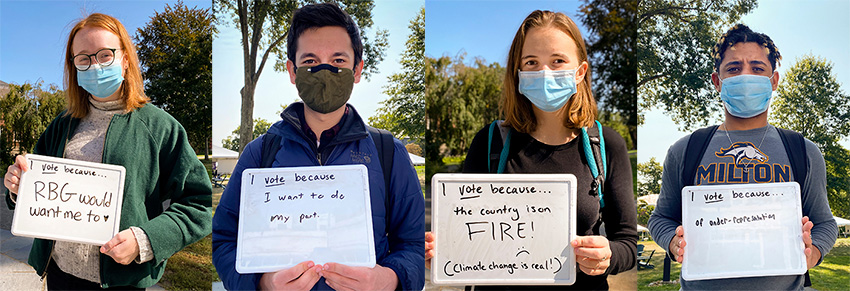
Student participants in the “Why I Vote” event.
Our commitment to the urgency of climate action has led to significant progress toward our goal of carbon neutrality by 2030 as outlined in our Climate Action Plan. The performance characteristics of the 800-foot-deep geothermal exchange test well that was drilled this summer on the southern edge of the campus exceeded expectations and predictions, clearing the way for the next step in the transformation of our energy system from fossil fuels to renewable electricity.
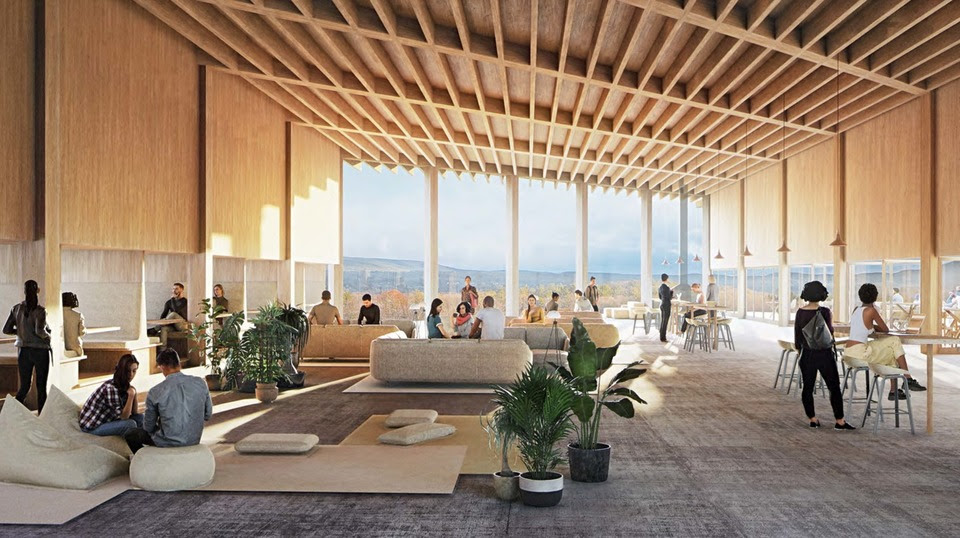
Architects’ rendering of interior space in the new Student Center; view of the Holyoke Range.
Despite the budgetary constraints the pandemic has caused, we are determined to make progress, with donor support, on two important, energy-efficient capital projects. Architects Herzog & de Meuron have developed an inspiring conceptual design for a beautifully sited Student Center that will support a vibrant sense of community, nurture student wellbeing, and offer students the kinds of social spaces currently in short supply on campus. And, thanks to the generosity of donors, we are planning the renovation and expansion of 197 South Pleasant Street to create a Lyceum, an interdisciplinary home for humanistic exploration, including the Center for Humanistic Inquiry and the Department of History. I’ll be sharing more about both of these projects over the coming months.
A Community Effort
Alumni and parents are always important to the efforts of the Loeb Center for Career Exploration and Planning; in light of the heightened competitiveness of the job market in a recession, alumni and parent engagement has become even more essential. Our Alumni-in-Residence program, a highlight of the Loeb’s full calendar of virtual events, invites alumni to share candid career conversations to help students explore possibilities, build relationships, and get real-world advice. In collaboration with Advancement, Loeb staff have also launched an alumni and parent engagement campaign called Hire A Mammoth to generate connections, internships, and jobs for Amherst students. This campaign kicked off in summer 2020 and netted 72 remote internship offers for Amherst students. Efforts will continue for both internship and post-college employment opportunities in the coming year. If you’re interested in engaging with any of our Loeb programming, reach out to the Center’s director, Emily Griffen.
Our community has pulled together in response to the challenges of this moment. The faculty and staff have worked hard to make the health and safety of our community a priority and to provide the best learning experience for our students. In turn, our students have stepped up with maturity, flexibility, and understanding. Our alumni and parents have rallied to support the College and Amherst students in a wide range of crucially important ways, including generous support of our COVID-19 Student Emergency Fund, which allows us to support essential student transport, technology, and living needs. Because of the generosity of generations of alumni, families, and friends who have made gifts at every level, the College entered this period of great uncertainty in a position of relative strength. In the midst of economic and societal instability, it is a testament to the power of our shared values that so many of you have continued, or even increased, your support of the College: the Amherst Fund finished the 2019-20 fiscal year on June 30 with a combined, record-breaking $11.4 million in gifts to the Alumni Fund, the COVID-19 Student Emergency Fund, and the Parents’ Fund. As the Promise campaign enters its third year, we have raised $496 million, putting us at nearly 80 percent of our $625 million goal.
The past few months have shown just how much each and every gift matters to our students and faculty, from the $30 contributed by a graduating senior that is the equivalent of two weeks of WiFi service for a student studying remotely to a multimillion-dollar pledge to underwrite capital needs. The financial impact of COVID-19 will be with us for some time to come. Chief Financial and Administrative Officer Kevin Weinman recently outlined the adjustments to our budget and financial strategy in a letter to our campus community. As we look at expenditures that would have been unimaginable six months ago—tents for outdoor classes, online learning enhancements, PPE and COVID-19 testing protocols—I urge you to support the Amherst Fund to the best of your ability. Your giving to the Fund upholds the core tenets of the Amherst experience, from financial aid that reflects our commitment to access and affordability, to support for new faculty and their research and teaching.
I thank all of you for your many different ways of contributing to the College, and close with my hope that you will take good care of yourselves and others during this challenging time.
Biddy